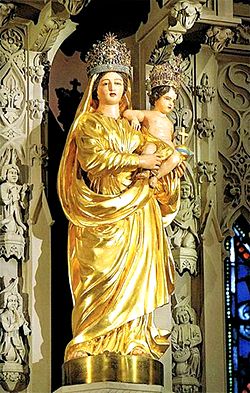
Our Lady of Fátima is a Catholic title of Mary, mother of Jesus, based on the Marian apparitions reported in 1917 by three shepherd children at the Cova da Iria in Fátima, Portugal. The three children were Lúcia dos Santos and her cousins Francisco and Jacinta Marto. José Alves Correia da Silva, Bishop of Leiria, declared the events worthy of belief on 13 October 1930.

Our Lady of Peace, Mother of Peace, Queen of Peace or Our Lady Queen of Peace is a title of the Blessed Virgin Mary in the Roman Catholic Church. She is represented in art holding a dove and an olive branch, symbols of peace. Her official memorial in the General Roman Calendar is on July 9 in the universal Church except for Hawaii and some churches in the United States, where it is kept on January 24.

Our Lady of Mount Carmel, or Virgin of Carmel, is the title given to the Blessed Virgin Mary in her role as patroness of the Carmelite Order, particularly within the Catholic Church. The first Carmelites were Christian hermits living on Mount Carmel in the Holy Land during the late 12th and early to mid-13th century. They built in the midst of their hermitages a chapel which they dedicated to the Blessed Virgin, whom they conceived of in chivalric terms as the "Lady of the place." Our Lady of Mount Carmel was adopted in the 19th century as the patron saint of Chile.

Marian devotions are external pious practices directed to the person of Mary, mother of God, by members of certain Christian traditions. They are performed in Catholicism, High Church Lutheranism, Anglo-Catholicism, Eastern Orthodoxy and Oriental Orthodoxy, but generally rejected in other Christian denominations.

The Confraternities of the Cord are pious associations of Christians, the members of which wear a cord, girdle or cincture in honour of a Catholic saint or Angel whom they wish to honour and emulate.
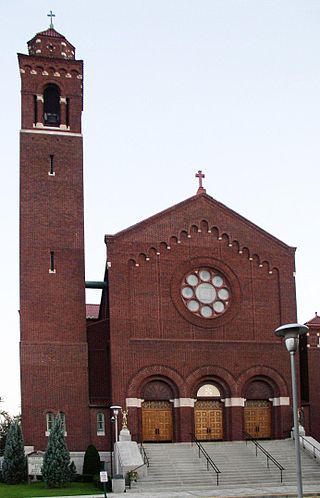
The Basilica and National Shrine of Our Lady of Consolation is a Roman Catholic basilica located in Carey, Ohio in the United States of America dedicated to the Blessed Virgin Mary under the title of Our Lady of Consolation. The Marian shrine is administered by the Order of Saint Francis and is designated as National shrine by the Holy Office.

Three Hail Marys are a traditional Roman Catholic devotional practice of reciting Hail Marys as a petition for purity and other virtues. Believers recommend that it be prayed after waking in the morning, and before going to bed. This devotion has been recommended by SS. Anthony of Padua, Alphonsus Liguori, John Bosco and Leonard of Port Maurice. Two saints, Mechtilde and Gertrude the Great, are said to have received revelations from the Blessed Virgin Mary regarding this practice.

Mary, the mother of Jesus in Christianity, is known by many different titles, epithets, invocations, and several names associated with places.

Our Lady of Manaoag is a Roman Catholic title of the Blessed Virgin Mary venerated in Manaoag, Pangasinan, the Philippines. The sacred statue is referred to as Apo Baket in the native language of local devotees.

May devotions to the Blessed Virgin Mary refer to special Marian devotions held in the Catholic Church during the month of May honoring Mary, mother of God, as "the Queen of May". These services may take place inside or outside. A "May Crowning" is a traditional Roman Catholic ritual that occurs in the month of May.

The veneration of Mary in the Catholic Church encompasses various devotions which include prayer, pious acts, visual arts, poetry, and music devoted to her. Popes have encouraged it, while also taking steps to reform some manifestations of it. The Holy See has insisted on the importance of distinguishing "true from false devotion, and authentic doctrine from its deformations by excess or defect". There are significantly more titles, feasts, and venerative Marian practices among Roman Catholics than in other Western Christian traditions. The term hyperdulia indicates the special veneration due to Mary, greater than the ordinary dulia for other saints, but utterly unlike the latria due only to God.
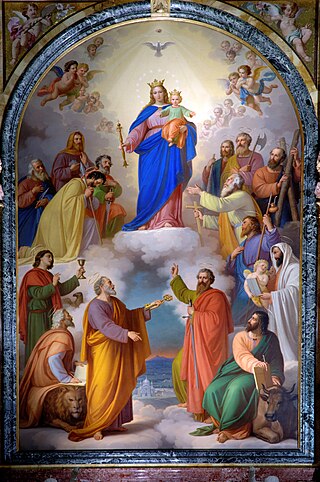
Mary, the Help of Christians, is a Roman Catholic title of the Blessed Virgin Mary, based on a religious devotion now associated with a feast day of the General Roman Calendar on 24 May.
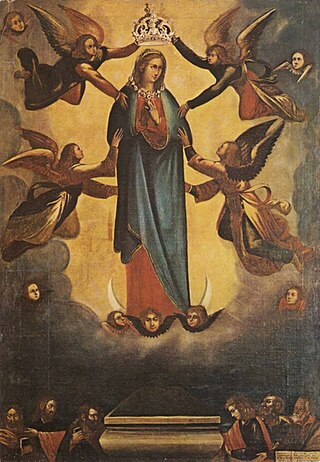
The Blessed Virgin of Ta' Pinu, or as it is known in Maltese, "Il-Madonna ta' Pinu" is a religious devotion which originated on Gozo, the sister island of Malta. The many Maltese and Gozitans living abroad have managed to spread this devotion in many other parts of the world. The Ta' Pinu Basilica, is based in Għarb.

Santuario della Madonna del Divino Amore, or the Shrine of Our Lady of Divine Love, is a Roman Catholic shrine in the southern outskirts of Rome dedicated to the Blessed Virgin Mary that consists of two churches: an old church built in 1745 and a new church added to the sanctuary in 1999. The church was included by Pope John Paul II in the pilgrimage of Seven Pilgrim Churches of Rome during the Holy Year 2000.

Our Lady of the Cape is a title given to Mary the Mother of God in Cap-de-la-Madeleine, Quebec Canada. The title refers specifically to a statue of the Blessed Mother which is currently located in the Old Shrine.

Our Lady of the Most Holy Rosary – La Naval de Manila is a venerated title of the Blessed Virgin Mary associated with the same image in the Philippines. Pious believers claim that the Virgin's intercession under this title helped to defeat the invading forces of the Protestant Dutch Republic during the Battles of La Naval de Manila in 1646.

Our Lady of Consolation or Mary, Comforter of the Afflicted is a title of the Blessed Virgin Mary and venerated in the Roman Catholic Church.
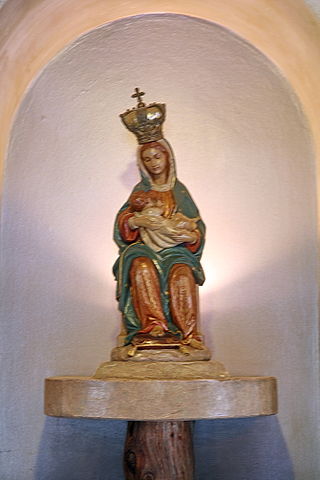
Our Lady of La Leche is a Catholic title of the Blessed Virgin Mary associated with a statue of her breastfeeding the infant Jesus Christ. It is said to be one of the oldest of all Marian devotions.

Our Lady of Africa, also known as Our Mother of Africa, is a Catholic title of the Blessed Virgin Mary associated with a statue of her as a Black woman, located in the major shrine of Notre-Dame d'Afrique in Algiers, Algeria. The devotion was spearheaded by Bishop Louis-Antoine-Augustin Pavy of Algiers, who established the basilica under that title in 1856.
